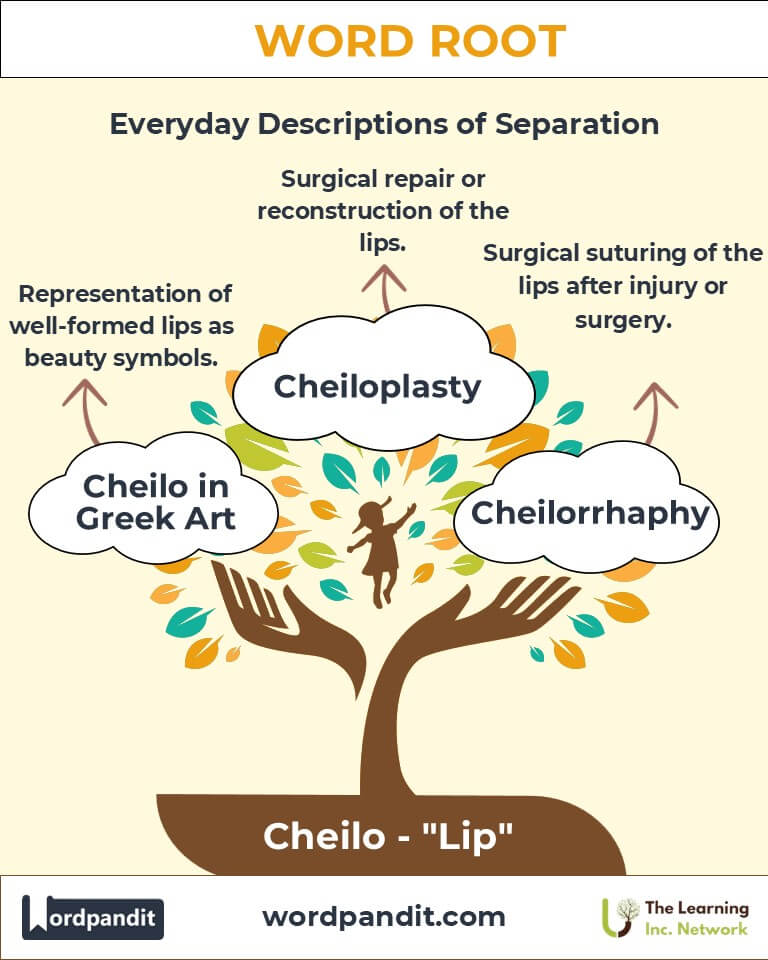Cheilo: The Language of Lips in Medicine and Beyond
Discover the intriguing world of the word root "cheilo," derived from the Greek "cheilos," meaning "lip." From medical conditions like cheilitis to reconstructive procedures like cheiloplasty, this root has shaped practices across medicine and anatomy.

1. Introduction: The Significance of Cheilo
Our lips play a central role in communication, expression, and health. The root "cheilo," pronounced kye-loh or kee-loh, stems from the Greek word for "lip" and is commonly used in medical terminology. From diagnosing cheilitis (lip inflammation) to procedures such as cheiloplasty (lip reconstruction), this root defines essential aspects of anatomy and care, spanning healthcare, culture, and aesthetics.

2. Etymology and Historical Journey
The root "cheilo" originates from the Greek word "cheilos," meaning "lip." Ancient Greek physicians used this term in medical texts to describe lip-related ailments and treatments. As Greek knowledge influenced Roman and European medicine, "cheilo" became entrenched in Latin-based medical terminology, shaping words still in use today.
3. Mnemonic: Unlocking the Power of Cheilo
Mnemonic Device: "Cheilo cares for lips, from cracks to curves."
Visualize lips shaped like the letter "C" with a smile, emphasizing the root "cheilo."
4. Common Cheilo-Related Terms
- Cheilitis (kye-LYE-tis): Inflammation of the lips.
Example: "Her cheilitis was caused by exposure to cold weather and dehydration." - Cheiloplasty (KYE-loh-plas-tee): Surgical repair or reconstruction of the lips.
Example: "Cheiloplasty is often performed to correct cleft lips in infants." - Cheilorrhaphy (kye-LOR-uh-fee): Surgical suturing of the lips.
Example: "After the accident, the surgeon performed cheilorrhaphy to repair the patient’s lip." - Angular Cheilitis (ANG-gyoo-lar kye-LYE-tis): Inflammation at the corners of the mouth.
Example: "Nutritional deficiencies often contribute to angular cheilitis."
5. Cheilo Through Time
- Ancient Practices: Greek and Roman physicians prescribed olive oil and honey to treat lip ailments.
- Modern Innovations: Cheiloplasty has become a life-changing procedure, particularly for children with cleft lips.
6. Cheilo in Specialized Fields
- Medicine: Cheilitis highlights issues like infections or deficiencies impacting the lips.
- Surgery: Cheiloplasty addresses congenital or trauma-related lip deformities.
- Cosmetic Dentistry: Cheilorrhaphy improves both lip function and appearance.
7. Illustrative Story: Cheilo in Action
Sarah was born with a cleft lip and underwent cheiloplasty at six months old. Years later, she became a motivational speaker, inspiring others through her journey. Her story highlights the transformative power of cheilo-related medical advancements.
8. Cultural Significance of Cheilo
Lips have symbolized beauty, eloquence, and emotion across cultures. Ancient Greek art celebrated well-formed lips as signs of beauty, a tradition that continues today in modern aesthetics and expressions of communication.

9. The Cheilo Family Tree
- Labio- (Latin: lip):
Example: Labiodental (concerning the lips and teeth). - Stomato- (Greek: mouth):
Example: Stomatology (study of the mouth and related structures).
FAQs About the Cheilo Word Root
Q1: What does the root "cheilo" mean, and where does it come from?
A: The root "cheilo" means "lip" and originates from the Greek word "cheilos," which directly refers to the anatomical structure. It is widely used in medical terminology to describe conditions, treatments, or procedures involving the lips.
Q2: Is "cheilo" only used in medical contexts?
A: While "cheilo" is most commonly found in medical terms, such as "cheilitis" (lip inflammation) and "cheiloplasty" (lip reconstruction), it has applications in broader contexts, including anatomy and cosmetic surgery. It focuses on the functional and aesthetic aspects of lips.
Q3: What is cheilitis, and what causes it?
A: Cheilitis refers to the inflammation of the lips, which can result from various factors, including environmental exposure (e.g., extreme cold or wind), nutritional deficiencies (such as vitamin B2 deficiency), allergies, or infections. It often presents as redness, cracking, or soreness of the lips.
Q4: What is the purpose of cheiloplasty?
A: Cheiloplasty is a surgical procedure aimed at repairing or reconstructing the lips. It is commonly performed to correct congenital conditions like cleft lips, address trauma-related injuries, or enhance the appearance of lips for cosmetic reasons. This procedure restores both function and aesthetics.
Q5: What distinguishes angular cheilitis from regular cheilitis?
A: Angular cheilitis specifically affects the corners of the mouth, causing painful cracks or sores, while regular cheilitis can impact the entire lip area. Angular cheilitis is often caused by saliva pooling, fungal or bacterial infections, or ill-fitting dentures.
Q6: How is cheilorrhaphy different from cheiloplasty?
A: Cheilorrhaphy refers specifically to the suturing of the lips, typically after trauma or surgery, to close a wound or incision. Cheiloplasty, on the other hand, involves a broader range of surgical techniques to reshape, repair, or reconstruct the lips.
Q7: Are there non-surgical treatments for cheilo-related conditions?
A: Yes, many cheilo-related conditions, like cheilitis, can be treated non-surgically with moisturizers, protective balms, antifungal or antibacterial medications, and dietary adjustments. Surgery is usually reserved for structural issues or severe cases.
Test Your Knowledge: Cheilo Word Root Quiz
1. What does the root "cheilo" mean?
2. Which term refers to surgical repair of the lips?
3. What is angular cheilitis?
4. What is cheilorrhaphy used for?
5. What is the primary cause of cheilitis?

12. Conclusion: The Enduring Legacy of Cheilo
The root "cheilo" connects health, beauty, and communication. Its presence in medical and linguistic contexts highlights the importance of lips in human life, ensuring that "cheilo" continues to shape our understanding and care for this vital feature.











